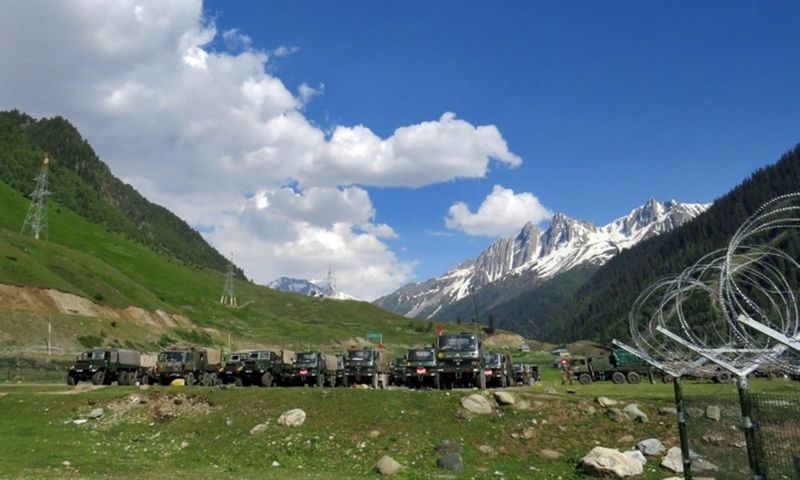
India and China are locked in an intense stand-off with their powerful militaries in an eyeball-to-eyeball confrontation along the Line of Actual Control (LAC) in Ladakh.
The latest clashes between the two neighbours have mainly taken place along the Galwan Valley in Ladakh (recently upgraded to a Union Territory after India scrapped the special status of Jammu and Kashmir).
On Tuesday the Indian army initially said a colonel and two soldiers were killed in violent clashes with Chinese troops. It later said that “17 Indian troops who were critically injured in the line of duty” died from their injuries, taking the “total that were killed in action to 20”. There may have been casualties on the Chinese side but Beijing has not put out a figure yet.
India and China share a 3,440km long border. Both countries have overlapping territorial claims. To understand the latest flashpoint between the two Asian powers, it is therefore important to understand the strategic significance of the area in which the two armies are positioned against each other.
The sudden interest in Galwan Valley might well be strategic. Part of the Ladakh region, Galwan is comprised of jarred mountain cliffs and rough terrain. With its harsh climate and high altitude terrain, it lies close to Aksai Chin, a disputed area (claimed by India) but effectively under the Chinese control
The Galwan Valley, located in eastern Ladakh, is a strategic area which gets its name from Galwan river that originates from the Aksai Chin region and joins the Shyok river. It is close to the vital road link to Daulat Beg Oldie (DBO), the world’s highest landing ground next to the LAC and serves as an important aerial supply line.
The region has been under Indian control. New Delhi alleges that in recent weeks Chinese troops in large numbers moved in at various points in Galwan, Hot Springs, Pangong Tso and Gogra (all in Ladakh).
Interestingly Galwan has not previously figured in any major disputes between the two Asian powers. Many Western military analysts conclude that the latest move could possibly be China’s signal that it is enlarging the areas of dispute.
The sudden interest in Galwan Valley might well be strategic. Part of the Ladakh region, Galwan is comprised of jarred mountain cliffs and rough terrain. With its harsh climate and high altitude terrain, it lies close to Aksai Chin, a disputed area (claimed by India) but effectively under the Chinese control.
Any work on the Indian side (construction of road infrastructure etc) has historically raised China’s hackles. Beijing suspects that such infrastructure building by India can help New Delhi move men and materiel rapidly in case of a major conflict.
Indeed India’s latest roadway runs almost parallel to the LAC and extends up to the base of the Karakoram Pass, which will cut travel time from Leh to DBO from the present two and a half days to just 5-6 hours.

The Kashmir angle
A growing battery of experts and China watchers are however linking the recent developments to Narendra Modi’s aggressive move to withdraw Kashmir’s special autonomy in August 2019.
Leading the chorus is a recent report by an influential Chinese think tank that says India’s move to abrogate Article 370 and splitting up Jammu and Kashmir into the Union territories of Jammu and Kashmir, and Ladakh has dismayed China.
Following the abrogation of Article 370, India opened “up new territory on the map” with respect to China, per the report by China Institute of Contemporary International Relations (CICIR).
It adds, “On the Chinese side, India ‘opened up new territory on the map,’ incorporated part of the areas under the local jurisdiction of Xinjiang and Tibet into its Ladakh Union territory, and placed Pakistani-administered Kashmir within its so-called Union territories of Jammu and Kashmir. This forced China into the Kashmir dispute, stimulated China and Pakistan to take counter-actions on the Kashmir issue and dramatically increased the difficulty in resolving the border issue between China and India."
While this is not the official Chinese position, this may well be the thinking in Beijing since CICIR is affiliated to China’s Ministry of State Security. With the latest developments, China could be inserting itself as a party to the Kashmir dispute. Already large parts of Kashmir, including Aksai Chin and Shaksgam valley (ceded to Beijing by Pakistan in 1963) are under Chinese control. If the calculation to split up the already restive Kashmir region — and create a new entity — was to exercise better geopolitical control over the area, it may not be working.
Ladakh face-off
Ladakh is divided into two districts, Leh and Kargil. Leh is Buddhist-dominated while Muslims are in majority in Kargil. Last year when Modi moved to split up Jammu and Kashmir, Ladakh became a separate entity, setting it apart geographically, administratively, and demographically from Kashmir.
The creation of India’s first Buddhist-majority Union Territory did not amuse Beijing, which called it New Delhi’s unilateral amendment to law to damage China’s territorial sovereignty.
Fast forward to May 2020, the Chinese forces started putting up tents, digging trenches and moving heavy equipment several kilometres inside what is regarded by India as its territory. Soldiers from both sides have clashed on at least on two previous occasions in Ladakh before Monday’s violent incident. Those scuffles were reported from Hot Springs and Pangong lake.

The lake, 135km long, a popular tourist destination in Ladakh is divided between India and China. In as many as 8 places, mountain peaks jut into the lake. These are officially referred to as ‘fingers’. While India lays claim till Finger 8, many reports suggest that Chinese soldiers may have made incursions well into Finger 4.
With tempers fraying on both sides, a circumspect US on Wednesday called for ‘peaceful resolution’ of India-China showdown. While New Delhi is looking at understated support from the West, Beijing would be cautiously watching the developments for any hedges against China.
As the world battles the coronavirus pandemic, the deep territorial discord between India and China could not have worsened at a more fraught moment.





